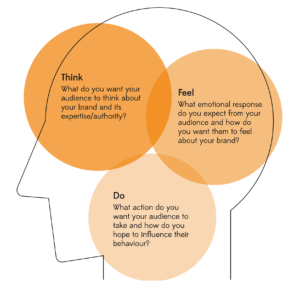Think, Feel, Do: How to use content to get an audience response

In a previous post, we discussed the role of emotion in B2B marketing and thought leadership, and debunked the myth that B2B purchasing is more rational than B2C. And our recent webinar reiterated that whilst buying decisions in B2B are highly complex and often career-defining moments, audiences don’t always seek out informative and instructional content to reaffirm their choices. They want to be reassured on an emotional level as well.
How can marketers balance the need for rational and emotional content in their campaigns? And what do they need to consider when they do the upfront planning?
Start with a new model

Our Thought leadership strategy ebook introduces the Think, Feel, Do model. A simple set of guiding principles we use to help shape our clients’ thought leadership programmes and links directly back to their overall objectives.
The model encourages the marketer to think about how they want audiences to respond to their content:
Think: What do you want your audience to think about your brand and its expertise/authority
Feel: What emotional response do you expect from your audience and how do you want them to feel about your brand?
Do: What action do you want your audience to take and how do you hope to influence their behaviour?
Do we think in two different ways?
In his book Thinking, Fast and Slow, Daniel Kahneman challenges the traditional view that human beings are predisposed to making decisions based on the logical processing of critical information.
Instead, says Kahneman, there are two different processes at work – System 1 (fast thinking, which is directly linked to emotion), and System 2 (slow thinking, which links to rational reasoning). The two systems often work independently from one another, and may or may not lead to the same outcome.
System 1 deals with decisions that require less cognitive thought and more instinct (for example, detecting hostility in a voice)
System 2 deals with issues that require conscious attention (for example, finding a woman with white hair in a crowd).
Crucially, Kahneman describes situations where System 1 and System 2 work together to help an individual make a complex decision. B2B decision-making falls into this category.
When the systems come together
Choosing a new cybersecurity supplier in the corporate world is a heavy burden for any individual. It is a complex decision, with a lot of factors and moving parts to consider. You might assume that Kahneman’s System 2 would rule here.
Often, however, these big decisions turn into a long, drawn-out process and, over time, the decision-maker may be more persuaded by a gut feeling, or instinct. Which brings System 1 into the equation. Suddenly, a balance has to be struck between ‘rational thinking’ and ‘emotional thinking’.
So Kahneman’s theory explains the Think and Feel components of our Think, Feel, Do model, but what about the Do?
It’s all well and good capturing your audience’s attention with a powerful headline and holding their interest with lots of insightful content, but if you don’t make the next step clear to them, how will you influence their behaviour?
Actionable insight should be at the heart of all thought leadership.
Think, Feel, Do in action
Here are three examples of thought leadership campaigns that use each element of the Think, Feel, Do model.
THINK: Cytiva
Cytiva’s Global Biopharma Resilience Index is a great example of ‘rational’ content. At the heart of the campaign is a fascinating piece of research that measures the resilience of the biopharma industry across five factors, including the supply chain and the talent pool.
It encourages us to think about the implications of the past year and the greatest public health crisis in recent memory, and to reflect on the future role of biopharma in the lives of populations around the world.
FEEL: Philips
The Longest Night is a very different style of thought leadership from Philips. The company is perhaps best known for its TVs, radios and lightbulbs, but is transforming into a healthcare company.
Launched to coincide with World Sleep Day in 2016, the campaign centres around the story of an Icelandic fisherman with insomnia and includes this powerful video. It’s great storytelling and emotional in its approach – but it still makes the point that Philips’ investment in tech can help with sleep problems.
DO: Hogan Lovells
Finally, Hogan Lovells’ Litigation Landscape, which has one purpose: to create conversations. From the title – ‘How to prevail when technology fails’ – to the recommendations based on client experience, it is a practical piece of thought leadership that has a very clear next step for the reader.
We recommend that you think about all three elements of Think, Feel, Do when you plan your content programme. But it is also important to recognise that a single content asset may not achieve all three. For every piece of content you create, aim to address at least one of these responses, and be sure to direct them to the next piece of insight that enables them to continue on their journey.
Sign up to the newsletter
We help organisations stand out, speak with authority and spark inspiration, so change can happen. That’s real intelligence with influence. Sign up to our newsletter to get regular updates.
Subscribe






 Back
Back

 Book a meeting
Book a meeting
 Book a meeting
Book a meeting

